In pics: portraits of villagers in Tibet
Xinhua
1597924135000
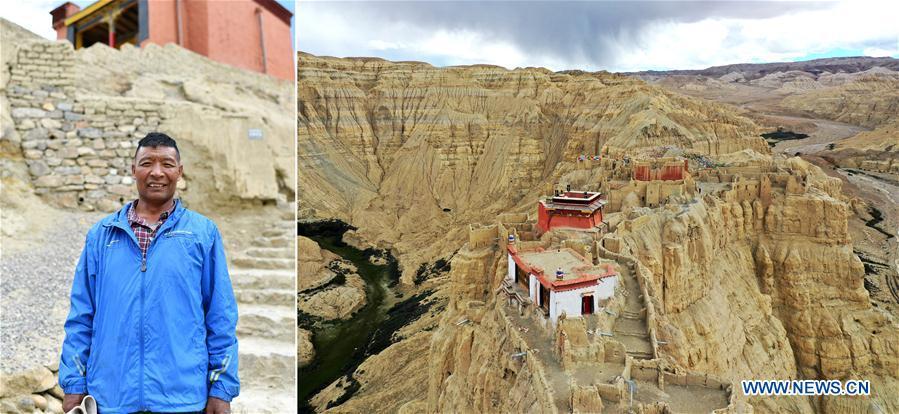
In this combination photo taken on July 26, 2020, the left part is a portrait of villager Gesang Qoipei at the historical site of the ancient Guge Kingdom near Zhaburang Village of Zanda County, Ngari Prefecture, southwest China's Tibet Autonomous Region; and the right part shows an aerial view of the ancient Guge Kingdom historical site in Zanda County. Gesang Qoipei works on a conservation team for cultural relics related to the ancient Guge Kingdom. He has also invested in a family hotel catering to tourists while acting as a part time guide. In recent years, Tibet Autonomous Region gives high priority to poverty alleviation and takes effective measures to improve the living and working conditions of locals. The poverty relief policies have benefited 628,000 registered poor residents in the region. (Xinhua/Zhan Yan)
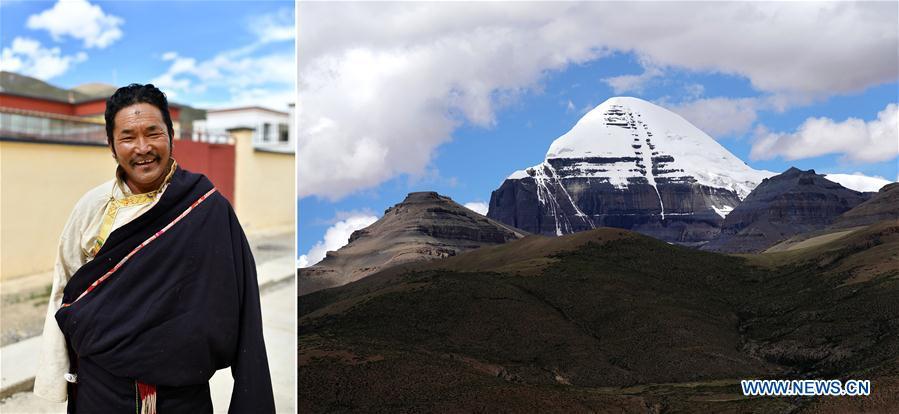
In this combination photo taken on July 27, 2020, the left part is a portrait of villager Gangma Daje in Gangsha Village of Burang County, Ngari Prefecture, southwest China's Tibet Autonomous Region; and the right part shows Mount Kangrinboqe in Burang County. Gangma Daje now earns a good livelihood by offering tourist services at the foot of Mount Kangrinboqe. In recent years, Tibet Autonomous Region gives high priority to poverty alleviation and takes effective measures to improve the living and working conditions of locals. The poverty relief policies have benefited 628,000 registered poor residents in the region. (Xinhua/Zhan Yan)

In this combination photo taken on July 31, 2020, the left part is a portrait of villager Badain Como in Bangbug Village of Tingri County, Xigaze, southwest China's Tibet Autonomous Region; and the right part shows Badain Como collecting her husband Wangdi's salary at the animal husbandry collective of Bangbug Village. Wangdi earns 3,000 yuan (433 U.S. dollars) a month herding for the collective, which also offers him dividends at the end of the year. In recent years, Tibet Autonomous Region gives high priority to poverty alleviation and takes effective measures to improve the living and working conditions of locals. The poverty relief policies have benefited 628,000 registered poor residents in the region. (Xinhua/Zhan Yan)
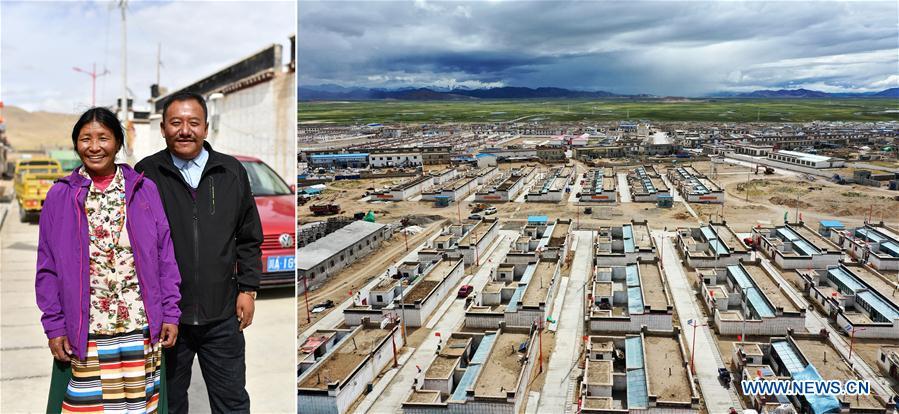
In this combination photo taken on July 29, 2020, the left part shows villager Tsering Dorje (R) posing with his wife Nanta in Dara Village of Zhongba County, Xigaze, southwest China's Tibet Autonomous Region; and the right part shows an aerial view of Dara Village. In 2017, Tsering Dorje and his family moved into a new residence with better village infrastructure and transportation. He now works at a village cooperative which provides him steady monthly income plus annual dividends. In recent years, Tibet Autonomous Region gives high priority to poverty alleviation and takes effective measures to improve the living and working conditions of locals. The poverty relief policies have benefited 628,000 registered poor residents in the region. (Xinhua/Zhan Yan)
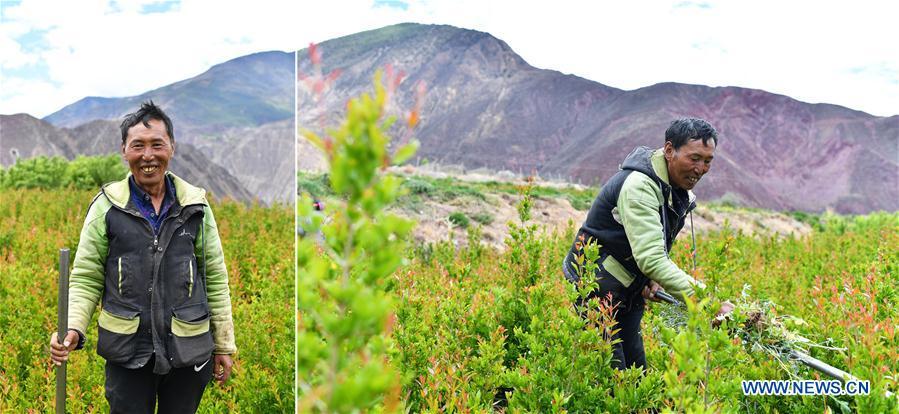
In this combination photo taken on May 4, 2020, the left part is a portrait of villager Tubdain Qupei in Markam County, Qamdo, southwest China's Tibet Autonomous Region; and the right part shows Tubdain Qupei working at an agricultural collective in Markam County. Tubdain Qupei has spent years planting trees and feeding cattle at the agricultural collective, which pays him 3,000 yuan (433 U.S. dollars) every month. In recent years, Tibet Autonomous Region gives high priority to poverty alleviation and takes effective measures to improve the living and working conditions of locals. The poverty relief policies have benefited 628,000 registered poor residents in the region. (Xinhua/Zhan Yan)
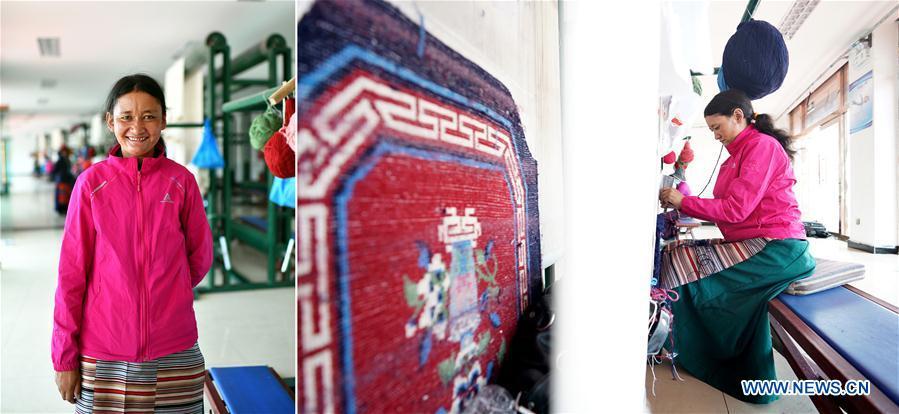
In this combination photo taken on July 25, 2020, Gangzeng poses for photos (L) and works at a garment and carpet factory at Kangle Xinju poverty-relief relocation site in Gar County, southwest China's Tibet Autonomous Region. Kangle Xinju poverty-relief relocation site is home to over 2,000 plateau residents who have relocated from less hospitable areas. Gangzeng had moved to Kangle Xinju from Gerze County of Ngari Prefecture in 2017 and her family now live in a 125-square-meter residence. Gangzeng has been re-employed at a garment and carpet factory here. In recent years, Tibet Autonomous Region gives high priority to poverty alleviation and takes effective measures to improve the living and working conditions of locals. The poverty relief policies have benefited 628,000 registered poor residents in the region. (Xinhua/Zhan Yan)
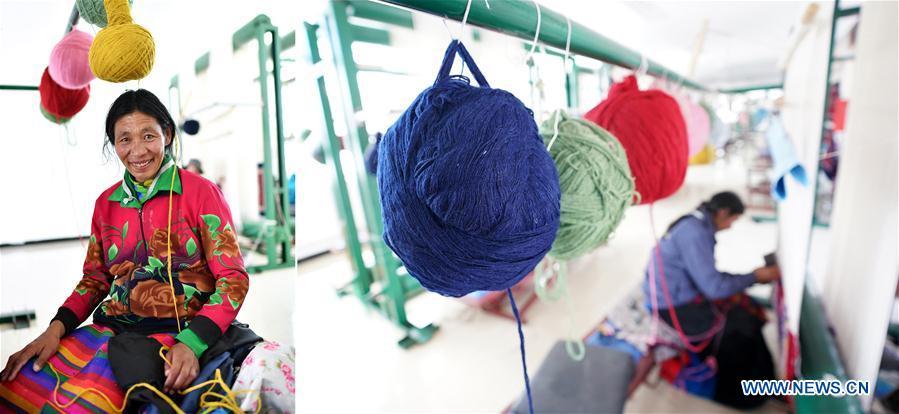
In this combination photo taken on July 25, 2020, Yangzhuo poses for photos (L) and works at a garment and carpet factory at Kangle Xinju poverty-relief relocation site in Gar County, southwest China's Tibet Autonomous Region. Kangle Xinju poverty-relief relocation site is home to over 2,000 plateau residents who have relocated from less hospitable areas. Yangzhuo had moved to Kangle Xinju from Gerze County of Ngari Prefecture in 2017 and her family now live in a 125-square-meter residence. Yangzhuo and her daughter have been re-employed at a garment and carpet factory here. In recent years, Tibet Autonomous Region gives high priority to poverty alleviation and takes effective measures to improve the living and working conditions of locals. The poverty relief policies have benefited 628,000 registered poor residents in the region. (Xinhua/Zhan Yan)
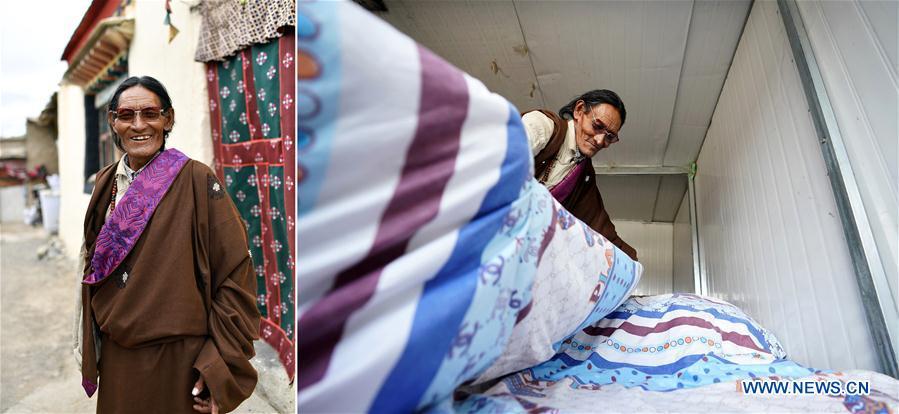
In this combination photo taken on July 27, 2020, the left part is a portrait of villager Tsering Qoipei in Gangsha Village of Burang County, Ngari Prefecture, southwest China's Tibet Autonomous Region; and the right part shows Tsering Qoipei making bed at the family hotel he runs in Gangsha Village, which lies at the foot of Mount Kangrinboqe. Many residents of Gangsha Village now earn a good livelihood by offering tourist services at the foot of Mount Kangrinboqe. In recent years, Tibet Autonomous Region gives high priority to poverty alleviation and takes effective measures to improve the living and working conditions of locals. The poverty relief policies have benefited 628,000 registered poor residents in the region. (Xinhua/Zhan Yan)
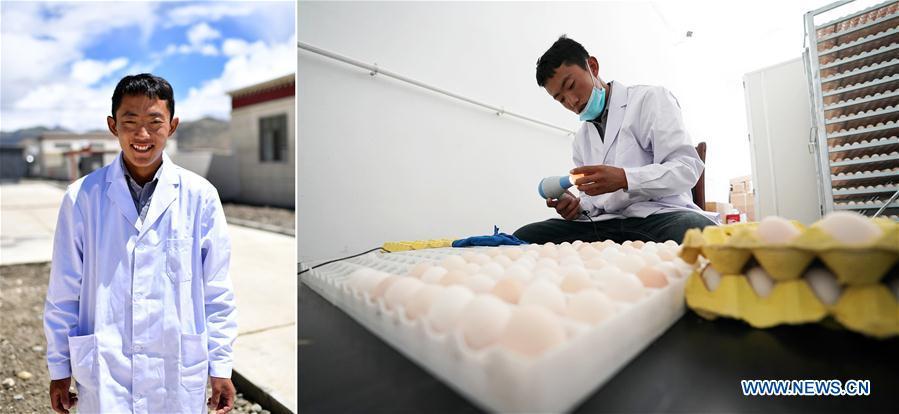
In this combination photo taken on Aug. 1, 2020, the left part is a portrait of villager Bianzeng in Lhaze County, Xigaze, southwest China's Tibet Autonomous Region; and the right part shows Bianzeng checking on eggs at a Tibetan chicken breeding center in Lhaze County. Bianzeng works at the Tibetan chicken breeding center with a monthly salary of 4,000 yuan (578 U.S. dollars). In recent years, Tibet Autonomous Region gives high priority to poverty alleviation and takes effective measures to improve the living and working conditions of locals. The poverty relief policies have benefited 628,000 registered poor residents in the region. (Xinhua/Zhan Yan)

In this combination photo taken on Aug. 1, 2020, the left part is a portrait of villager Zhoigar in Lhaze County, Xigaze, southwest China's Tibet Autonomous Region; and the right part shows Zhoigar working at a local chicken breeding center in Lhaze County. Zhoigar started working at the chicken breeding center at the beginning of 2020 with a monthly salary of 4,000 yuan (578 U.S. dollars). In recent years, Tibet Autonomous Region gives high priority to poverty alleviation and takes effective measures to improve the living and working conditions of locals. The poverty relief policies have benefited 628,000 registered poor residents in the region. (Xinhua/Zhan Yan)
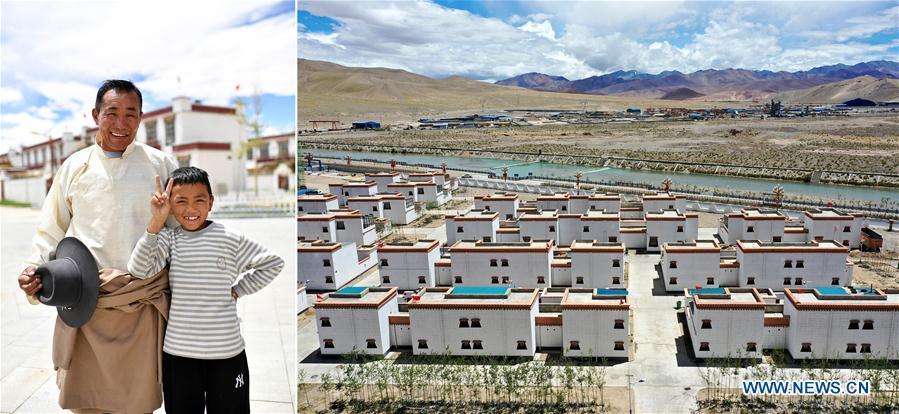
In this combination photo taken on July 25, 2020, the left part shows villager Toinzhub Dorje posing with his grandson Qumda at the Kangle Xinju poverty-relief relocation site in Gar County, southwest China's Tibet Autonomous Region; and the right part shows an aerial view of Kangle Xinju, which is home to over 2,000 plateau residents who have relocated from less hospitable areas. Toinzhub Dorje had moved to Kangle Xinju from Gerze County of Ngari Prefecture in 2017. The family now live in a 100-square-meter residence with full access to clinic, kindergarten, activity center and other amenities. In recent years, Tibet Autonomous Region gives high priority to poverty alleviation and takes effective measures to improve the living and working conditions of locals. The poverty relief policies have benefited 628,000 registered poor residents in the region. (Xinhua/Zhan Yan)
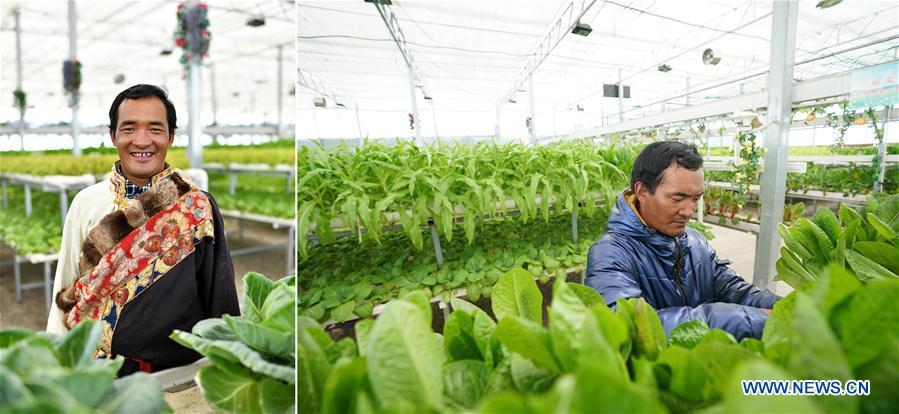
In this combination photo taken on July 25, 2020, the left part shows villager Sujia posing at an eco-friendly agricultural industrial park in Gar County, Ngari Prefecture, southwest China's Tibet Autonomous Region; and the right part shows Sujia checking vegetable growth at the eco-friendly agricultural industrial park. Sujia started learning vegetable farming techniques at the agricultural industrial park in 2017. He has become an experienced vegetable farmer with a monthly salary of 6,000 yuan (866 U.S. dollars). In recent years, Tibet Autonomous Region gives high priority to poverty alleviation and takes effective measures to improve the living and working conditions of locals. The poverty relief policies have benefited 628,000 registered poor residents in the region. (Xinhua/Zhan Yan)
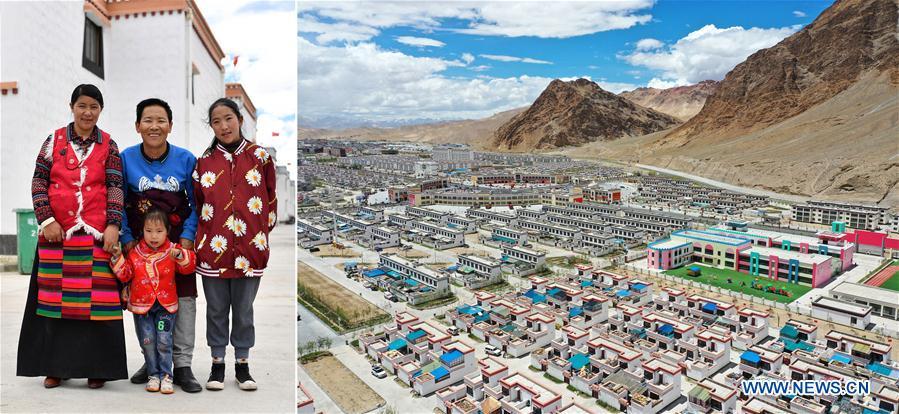
In this combination photo taken on July 25, 2020, the left part shows villager Danmuzhen (C, rear) posing with his wife Tashi Lhamo (L, rear) and two daughters in front of their new residence at the Kangle Xinju poverty-relief relocation site in Gar County, southwest China's Tibet Autonomous Region; and the right part shows an aerial view of Kangle Xinju, which is home to over 2,000 plateau residents who have relocated from less hospitable areas. Danmuzhen had moved to Kangle Xinju from Rutog County of Ngari Prefecture in 2018. The family now live in a 150-square-meter residence with full access to clinic, kindergarten, activity center and other amenities. In recent years, Tibet Autonomous Region gives high priority to poverty alleviation and takes effective measures to improve the living and working conditions of locals. The poverty relief policies have benefited 628,000 registered poor residents in the region. (Xinhua/Zhan Yan)
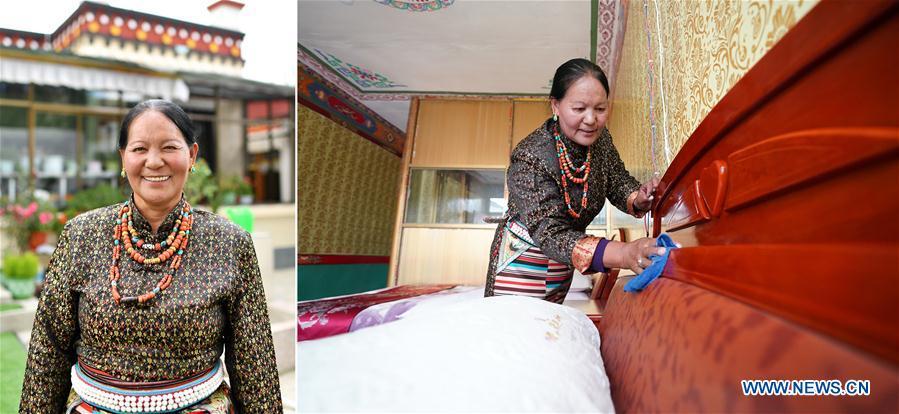
In this combination photo taken on July 26, 2020, the left part is a portrait of villager Jingzhoi Degyi at the family hotel she runs in Zhaburang Village of Zanda County, Ngari Prefecture, southwest China's Tibet Autonomous Region; and the right part shows Jingzhoi Degyi cleaning a room in her family hotel. Like Jingzhoi Degyi, many residents of Zhaburang Village have invested in tourism thanks to the village's proximity to the historical site of the ancient Guge Kingdom. In recent years, Tibet Autonomous Region gives high priority to poverty alleviation and takes effective measures to improve the living and working conditions of locals. The poverty relief policies have benefited 628,000 registered poor residents in the region. (Xinhua/Zhan Yan)
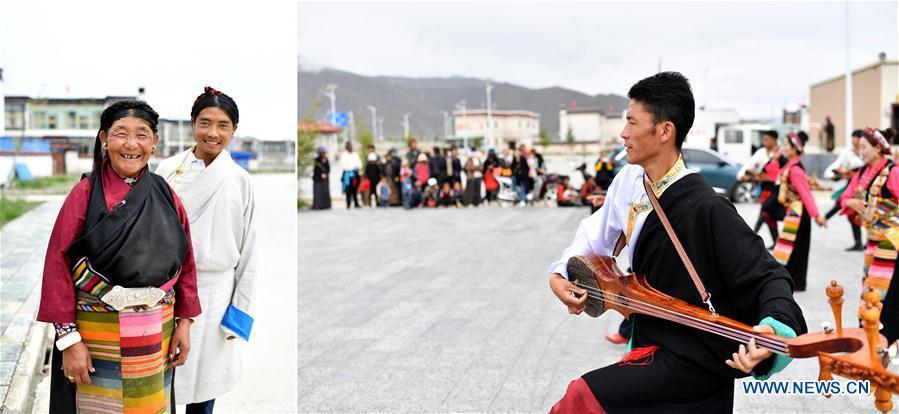
In this combination photo taken on Aug. 2, 2020, the left part shows villager Cangqung posing with her son Qoipei Cering in Mingma Village of Lhaze County, Xigaze, southwest China's Tibet Autonomous Region; and the right part shows troupe members performing for villagers at a relocation site in Mingma Village. All residents in Mingma Village have relocated to a new village site in 2016 in pursuit of better development. After relocation, Cangqung and her family now have access to leisure square, activity center, school and other amenities. Her life significantly improved with the opening of her own store, which brings her an annual income of 10,000 yuan (1,445 U.S. dollars). She is also entitled to dividends from a village cooperative. In recent years, Tibet Autonomous Region gives high priority to poverty alleviation and takes effective measures to improve the living and working conditions of locals. The poverty relief policies have benefited 628,000 registered poor residents in the re
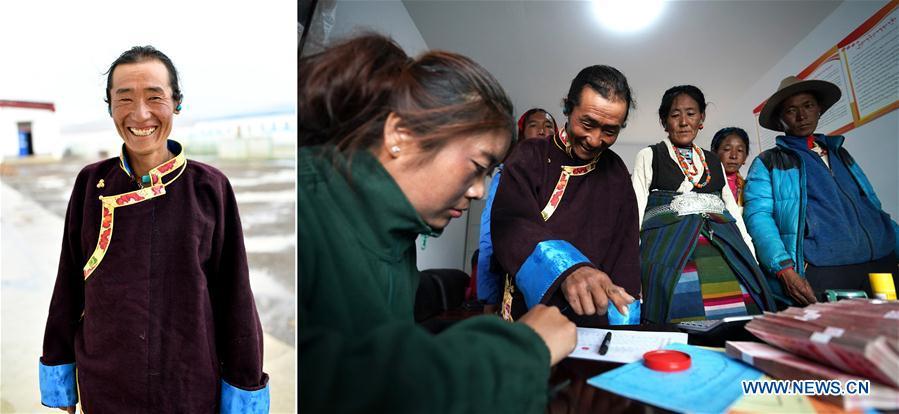
In this combination photo taken on July 31, 2020, the left part is a portrait of villager Ngawang Cuncheng in Bangbug Village of Tingri County, Xigaze, southwest China's Tibet Autonomous Region; and the right part shows Ngawang Cuncheng receiving his salary at the animal husbandry collective of Bangbug Village. In 2019, Ngawang joined the village collective with his herd of sheep. That year, he received a dividend of 9,700 yuan (1,401 U.S. dolars) from the collective. In recent years, Tibet Autonomous Region gives high priority to poverty alleviation and takes effective measures to improve the living and working conditions of locals. The poverty relief policies have benefited 628,000 registered poor residents in the region. (Xinhua/Zhan Yan)

In this combination photo taken on July 31, 2020, the left part is a portrait of villager Tonzhub in Bangbug Village of Tingri County, Xigaze, southwest China's Tibet Autonomous Region; and the right part shows Tonzhub feeding sheep at the animal husbandry of Bangbug Village. Tonzhub earns 3,500 yuan (506 U.S. dollars) a month taking care of sheep for the animal husbandry, which also offers him dividends at the end of the year. In recent years, Tibet Autonomous Region gives high priority to poverty alleviation and takes effective measures to improve the living and working conditions of locals. The poverty relief policies have benefited 628,000 registered poor residents in the region. (Xinhua/Zhan Yan)


